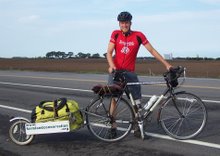An incredible trip to the North California Coast is worthy of picking up the keys again and sharing some beautiful photos.
In the summer of 2007 I had the good fortune to attend the Facilitating Sustainable Agriculture Conference (thanks Dr. J) and enjoyed my first visit to Ithaca, NY and the finger lakes region. I also got to catch up with an old Peace Corps buddy, Noelia Springston, and visit she and her husband's brand spanking new farm. As luck would have it I also got bumped on my US Airways flight up there and yippee for me, got a free ticket voucher out of the deal!
Well the last year's been a bit busy trying to get my Thesis finished, and I kept hoping I could really use that ticket as a reward for a thesis well defended. Well, the voucher was due to expire during the summer of '08 and I had to go ahead and use it or lose it so I guessed I might be done schooling and all by October and booked a ticket to San Francisco for October 10th.
Ha ha. My thesis ain't defended, but, it's job seeking time so that seems like a good excuse to go ahead and head on out there, right?
With a lot of help from my #1 farm buddy (a blonde canadian type) I got in touch with some farms to visit, scheduled a visit to the Center for Agroecology at Santa Cruz, shipped my bicycle UPS and away I went for 11 days of adventure.
So my first comment is that San Francisco just moved right up there to the top of my list of favorite American cities. Though I was quite disgruntled at the time, it was possibly to my good fortune that my bicycle on its ride out west was in a Train wreck and delayed for a few days, leaving me with some extra time to explore the city.
People often rave about the food in San Francisco and for good reason. I didn't have a bad meal the whole time. Here's a quick summary:
- the Market Bar @ the Ferry Building----Poached Eggs on Polenta with stewed tomatoes and swiss chard
- Cafe Divine @ Northbeach----- Porcini Ravioli, Homemade Gingerbread with caramel, and port for dessert
- Chez Panisse @ Berkley----- Baby lettuces with pomegrante, persimmon and fig, Roasted delicata squash, Roasted Fennel, and damn forgot the name of the chicken.
- Helmand Palace @ Van Ness---- Aushak - Afghan ravioli filled with leeks and scallions with mint/cilantro yogurt and beef sauce, Mourgh Challow - chicken and split pea curry, Rice Pudding.
- Mi Lindo Yucatan @ Noe Valley ---- shrimp/mango ceviche tostado, empanda, flauta, taco de Cochinita
So anyway eventually the bike came, I cheered right up and started heading south the 80 miles to Santa Cruz. I rode along the bay early one morning on my way out of town and this is what I saw.

and then the great GGB!

and then down the road a piece the California coast.


I broke myself in pretty good that day travelling 50+ miles. Went past the beautiful town of Pacifica and up and back down the Devils Slide (where these little photos were taken), then on to Pigeon Point Hostel which is one of two lighthouse hostels along this stretch of coast.

Hung out with some good folks here then early next morning had to hot foot it down to Santa Cruz to meet up with some folks at the Agroecology Center at UC Santa Cruz.
But I passed some groovy little places on the way. One of my favorites was Swanton Berry Farm which is one of the first organic strawberry farms in California. The place got my attention right off the bat with this great farm stand sign.

This place had the coolest farm stand I've ever seen. There were samples of strawberry jam on animal crackers, hot strawberry cider (yum), chocolate covered strawberries, strawberry shortcake, strawberry cheesecake, strawberry truffles (sooo good), pumpkin pie, then also cauliflower / leek soup....all organic. Then they had a sofa with a bookshelf filled with books about labor unions and cycling. I fell in love with this one book called the Noblest Invention - an Illustrated History of the Bicycle. I spent some quality time in this place both coming and going. Here's a quick shot of the simple building with a certified kitchen in back and some picnic tables out front.

And check this out. A little sumthin' for the cyclists! Yeah.

I'd run into another red and white sign early that morning as I was riding through literally miles of conventional Brussels Sprouts farms. They grow so many sprouts along this section of coast they actually have a Brussel Sprouts festival according to my Krebs cycling map. There were also sprouts all over the road, presumably swept out the back of hauling trucks. The sprout fields were quite beautiful and you could smell that sweet pungency of a Sprout.

But this red and white sign contrasts sharply with my friendly cycling sign in an eery but funny sort of way.

The Peligro Sprouts!
Well that's about all I got time for today. I'll see if I can't put some more stories up here in the next few days. And get back in the habit of writing.
























